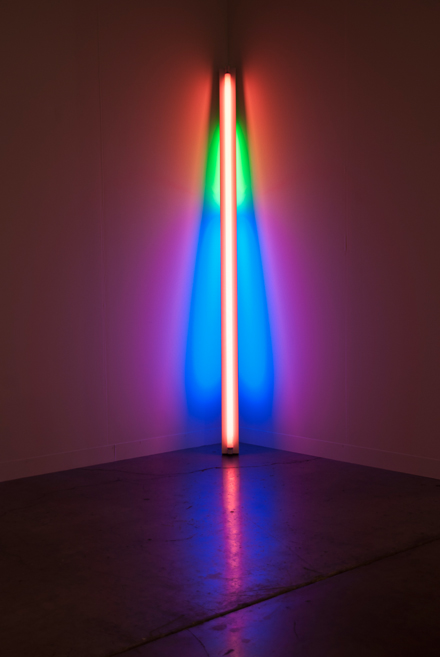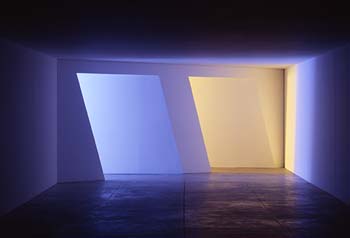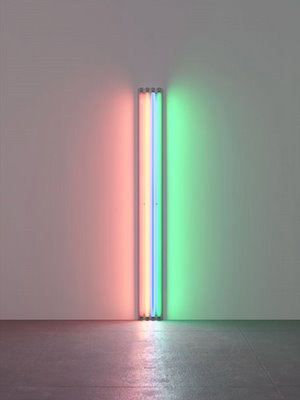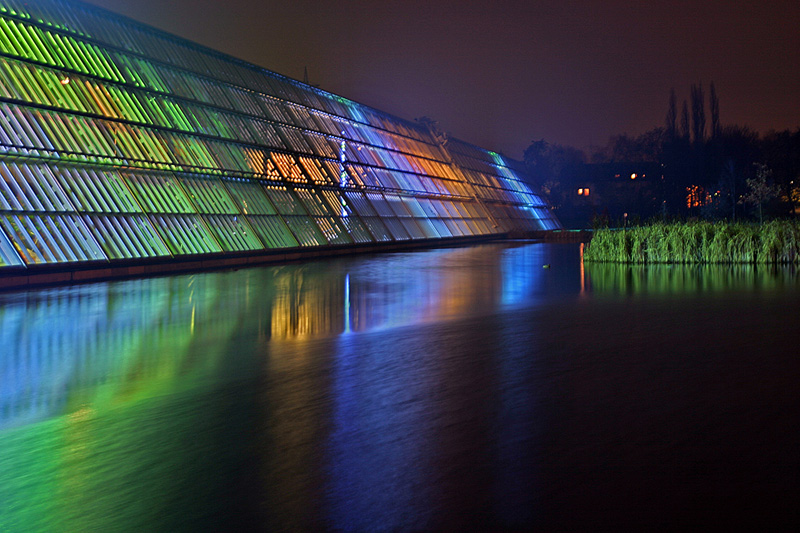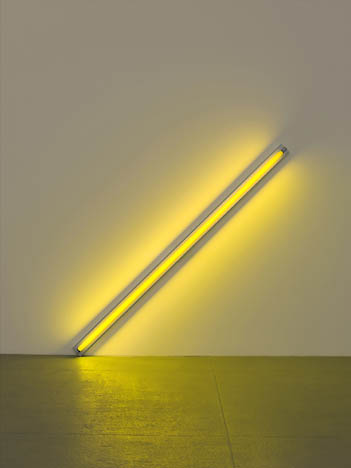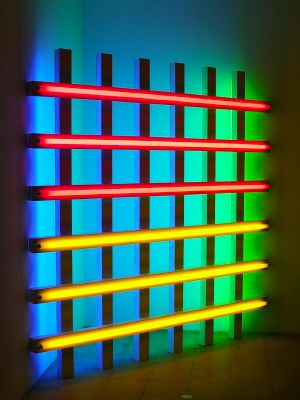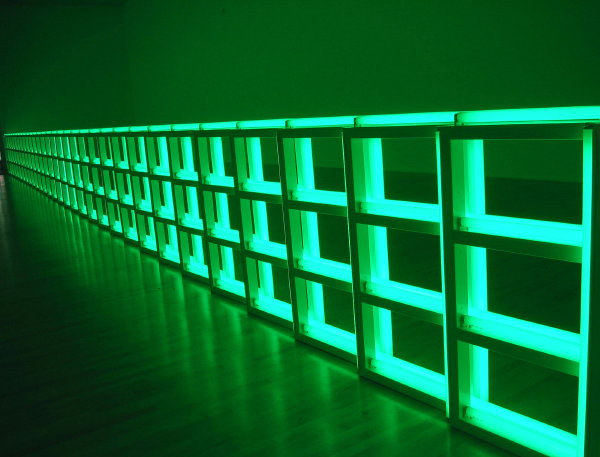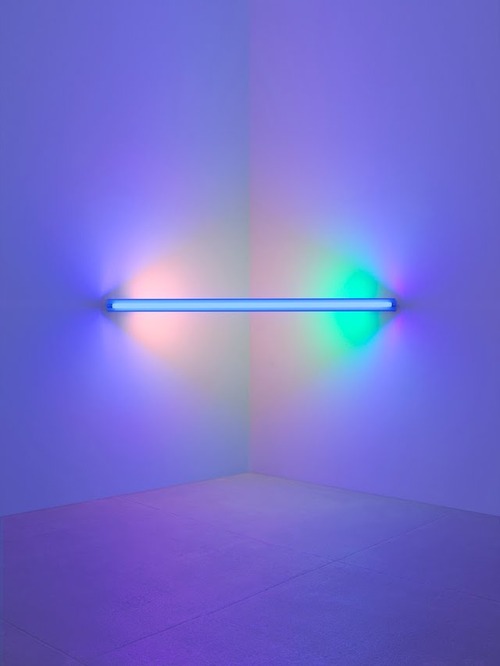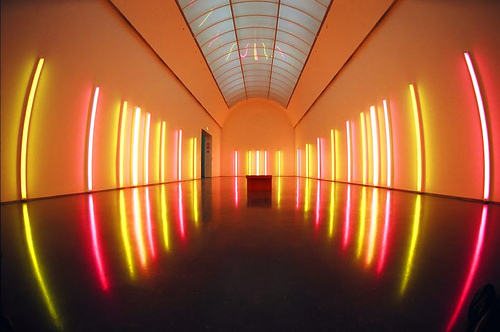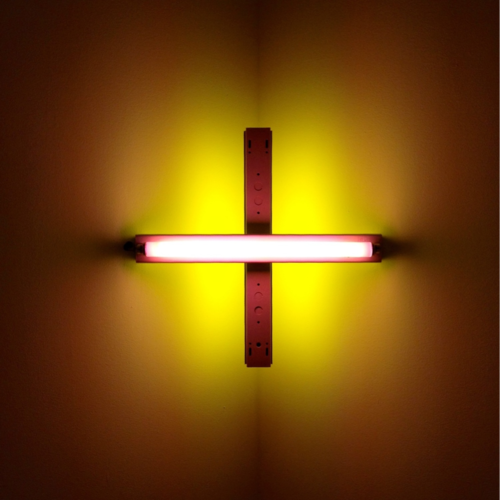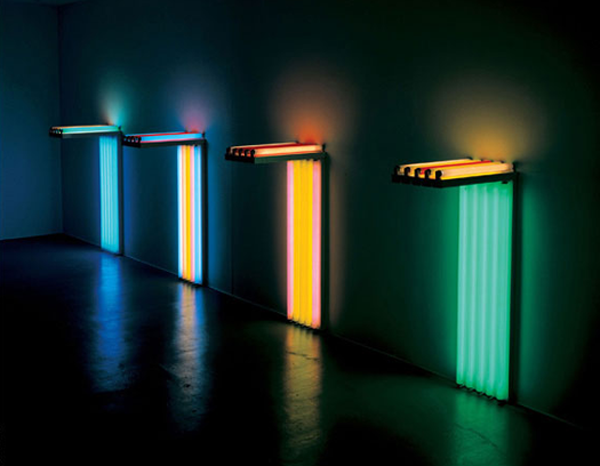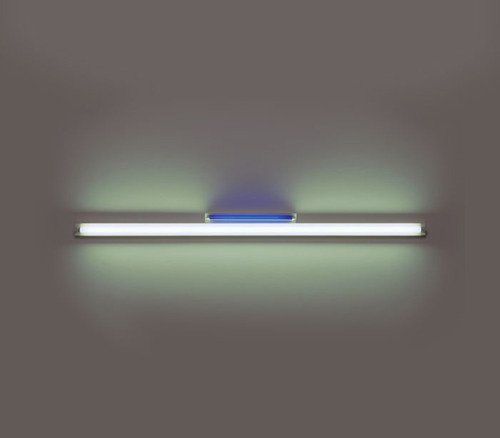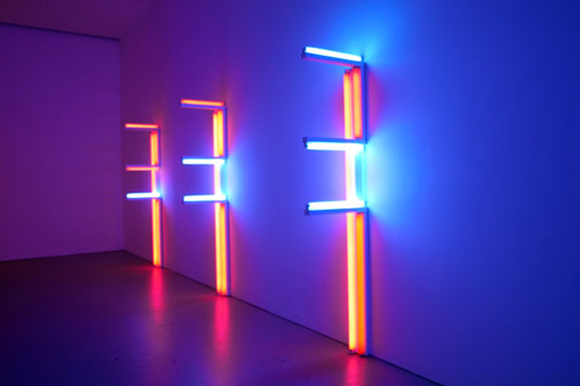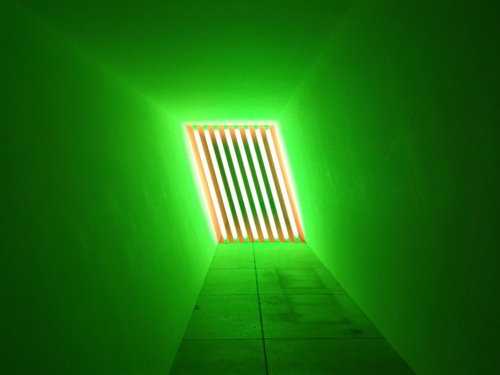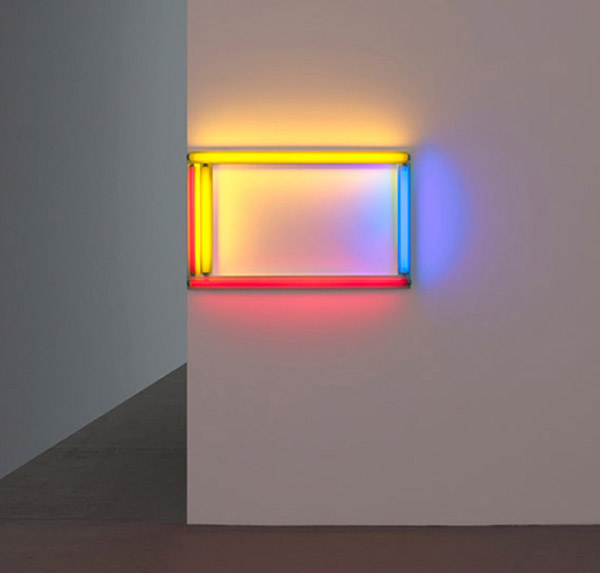<Back to Index>
- Installation Artist Dan Flavin, 1933
PAGE SPONSOR
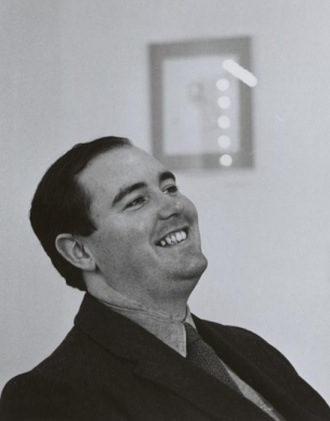
Dan Flavin (April 1, 1933, Jamaica, New York – November 29, 1996, Riverhead, New York) was an American minimalist artist famous for creating sculptural objects and installations from commercially available fluorescent light fixtures.
Daniel Nicholas Flavin Jr. was born in New York of Irish Catholic descent and sent to Catholic schools. He studied for the priesthood at the Immaculate Conception Preparatory Seminary in Brooklyn between 1947 and 1952 before leaving to join his fraternal twin brother, David John Flavin, and enlist in the United States Air Force. During military service in 1954 – 55, Flavin was trained as an air weather meteorological technician and studied art through the adult extension program of the University of Maryland in Korea. Upon his return to New York in 1956, Flavin briefly attended the Hans Hofmann School of Fine Arts and studied art under Albert Urban. He later studied art history for a short time at the New School for Social Research, then moved on to Columbia University, where he studied painting and drawing.
From 1959, Flavin was shortly employed as a mailroom clerk at the Guggenheim Museum and later as guard and elevator operator at the Museum of Modern Art, where he met Sol LeWitt, Lucy Lippard and Robert Ryman. Two years later, he married his first wife Sonja Severdija, an art history student at New York University and assistant office manager at the Museum of Modern Art.
Flavin married his second wife, the artist Tracy Harris, in a ceremony at the Guggenheim Museum, in 1992.
Flavin died in Riverhead, New York, of complications from diabetes. His estate is represented by David Zwirner, New York.
Flavin’s first works were drawings and paintings that reflected the influence of Abstract Expressionism. In 1959, he began to make assemblages and mixed media collages that included found objects from the streets, especially crushed cans.
In the summer of 1961, while working as a guard at the American Museum of Natural History in New York, Flavin started to make sketches for sculptures that incorporated electric lights. The first works to incorporate electric light were his "Icons" series: eight colored shallow, boxlike square constructions made from various materials such as wood, Formica, or Masonite. Constructed by the artist and his then wife Sonja, the Icons had fluorescent tubes with incandescent and fluorescent bulbs attached to their sides, and sometimes beveled edges. One of these icons was dedicated to Flavin's twin brother David, who died of polio in 1962."
The "Diagonal of Personal Ecstasy (the Diagonal of May 25, 1963)," a yellow fluorescent placed on a wall at a 45 degree angle from the floor and completed in 1963, was Flavin's first mature work; it is dedicated to Constantin Brâncuşi and marks the beginning of Flavin's exclusive use of commercially available fluorescent light as a medium. He confined himself to a limited palette (red, blue, green, pink, yellow, ultraviolet and four different whites) and form (straight two-, four-, six- and eight- foot tubes, and, beginning in 1972, circles). In the decades that followed, he continued to use fluorescent structures to explore color, light and sculptural space, in works that filled gallery interiors. He started to reject studio production in favor of site - specific “situations” or “proposals” (as the artist preferred to classify his work). These structures cast both light and an eerily colored shade, while taking a variety of forms, including "corner pieces", "barriers" and "corridors." Most of Flavin's works were untitled, followed by a dedication in parenthesis to friends, artists, critics and others: the most famous of these include his "Monuments to V. Tatlin," an homage to the Russian constructivist sculptor Vladimir Tatlin, a series of a total of fifty pieces which he continued to work on between 1964 and 1990.
Flavin realized his first full installation piece, greens crossing greens (to Piet Mondrian who lacked green), for an exhibition at the Van Abbemuseum, Eindhoven, Netherlands, in 1966. Flavin's "corridors", for example, control and impede the movement of the viewer through gallery space. They take various forms: some are bisected by two back - to - back rows of abutted fixtures, a divider that may be approached from either side but not penetrated (the color of the lamps differs from one side to the other). The first such corridor, untitled (to Jan and Ron Greenberg), was constructed for a 1973 solo exhibition at the St. Louis Art Museum, and is dedicated to a local gallerist and his wife. It is green and yellow; a gap (the width of a single "missing" fixture) reveals the cast glow of the color from beyond the divide. In subsequent barred corridors, Flavin would introduce regular spacing between the individual fixtures, thereby increasing the visibility of the light and allowing the colors to mix.
By 1968, Flavin had developed his sculptures into room size environments of light. That year, he outlined an entire gallery in ultraviolet light at Documenta 4 in Kassel, Germany. In 1992, Flavin’s original conception for a 1971 piece was fully realized in a site specific installation that filled the Solomon R. Guggenheim Museum's entire rotunda on the occasion of the museum’s reopening.
From 1975, Flavin installed permanent works in Europe and the United States, including the Rijksmuseum Kröller - Müller Museum, Otterlo, Netherlands (1977); Hudson River Museum, Yonkers, New York (1979); United States Courthouse, Anchorage, Alaska (1979 – 89); the Staatliche Kunsthalle Baden - Baden, Germany (1989); the lobby of the MetroTech Center (with Skidmore Owings & Merrill), Brooklyn, New York (1992); seven lampposts outside the Städtische Galerie im Lenbachhaus, Munich (1994); Hypovereinsbank, Munich (1995); Institut Arbeit und Technik / Wissenschaftspark, Gelsenkirchen, Germany (1996); and the Union Bank of Switzerland, Bern (1996). Additional sites for Flavin's architectural “interventions” became the Grand Central Station in New York (1976), Hamburger Bahnhof in Berlin (1996), and the Chinati Foundation in Marfa, Texas (2000). His large scale work in colored fluorescent light for six buildings at the Chinati Foundation was initiated in the early 1980s, although the final plans were not completed until 1996. His last artwork was a site specific work at Santa Maria Annunciata in Chiesa Rossa, Milan, Italy. The 1930s church was designed by Giovanni Muzio. The design for the piece was completed two days before Flavin's death on November 29, 1996. Its installation was completed one year later with the assistance of the Dia Center for the Arts and Fondazione Prada.
The Menil Collection in Houston, Texas, states that in 1990 Dominique de Menil approached Flavin to create a permanent, site specific installation at Richmond Hall. Just two days before his death in November 1996 Flavin completed the design for the space. The artist’s studio completed the work.
Living in Wainscott and Garrison, Flavin often drew the surrounding landscape, whether it was the Hudson Valley or the waters off Long Island. He also made small portraits and kept about 20 volumes of journals. Flavin collected drawings too, including works by Hudson River School artists like John Frederick Kensett, Jasper Francis Cropsey, and Sanford Robinson Gifford, along with examples of works on paper by early 19th century Japanese artists like Hokusai and 20th century European masters like Piet Mondrian and George Grosz. Flavin also exchanged works with Minimalist colleagues like Donald Judd and Sol LeWitt.
Flavin's first one - person exhibition using only fluorescent light opened at the Green Gallery in 1964. Two years later, his first European show opened at Rudolf Zwirner's gallery in Cologne, Germany. The first major retrospective of Flavin’s work was organized by the National Gallery of Canada, Ottawa, in 1969. In 1973 the Saint Louis Art Museum presented concurrent exhibitions of his works on paper and fluorescent sculptures. Among Flavin’s many significant one - person exhibitions in Europe were shows at the Kunstmuseum Basel and Kunsthalle Basel (1975), the Staatliche Kunsthalle, Baden - Baden (1989), and the Städel, Frankfurt (1993).
In the late 1970s, he began a partnership with the Dia Art Foundation that resulted in the making of several permanent site specific installations and led most recently to the organization of the traveling exhibition, Dan Flavin: A Retrospective (2004 – 2007). Flavin’s retrospective exhibition traveled to the Museum of Contemporary Art, Chicago; the National Gallery of Art, Washington, D.C.; the Museum of Modern Art, Fort Worth, Texas; Hayward Gallery, London; Musée d'Art Moderne de la Ville de Paris, Paris; Bayerische Staatsgemäldesammlungen, Pinakothek der Moderne, Munich; and the Los Angeles County Museum of Art, Los Angeles. This exhibition was the first comprehensive retrospective devoted to his minimalist work. The exhibition included nearly 45 light works, including his "icons" series. The MCA's presentation included the re-creation of the alternating pink and "gold" room from the original MCA exhibition in 1967, Flavin's first solo museum exhibition.
His first solo exhibition in Latin America was held at Fundación Proa, Buenos Aires, in 1998, organized with the Dia Art Foundation (Dan Flavin. 1933 - 96).
In 1964, Flavin received an award from the William and Norma Copley Foundation, Chicago, with a recommendation from Marcel Duchamp. In 1973, he was named Albert Dorne Visiting Professor at the University of Bridgeport, Connecticut, and in 1976, he was given the Skowhegan Medal of Sculpture from Skowhegan School of Painting and Sculpture, Maine. In 1983, the Dia Center for the Arts opened the Dan Flavin Art Institute in Bridgehampton, New York, a permanent exhibition of his works, designed by the artist in a converted firehouse.
In 2004, Ridinghouse and Thames & Hudson published It Is What It Is: Dan Flavin Since 1964, which assembles for the first time key essays on Flavin and reviews of his exhibitions. Spanning four decades, it charts the gradual evolution of consensus about the meaning of his art. Edited by Paula Feldman and Karsten Schubert, It Is What It Is includes texts by some of the most influential art historians and critics of today, such as Donald Judd, Dore Ashton, Rosalind Krauss, Lawrence Alloway, Germano Celant, Holland Cotter.
When financial assistance for projects sponsored by the Dia Art Foundation were suspended in 1986, Flavin began, with the encouragement of the Leo Castelli Gallery, affiliations with a number of American and European galleries, including the Margo Leavin Gallery, Los Angeles; the Donald Young Gallery, Chicago; the Texas Gallery, Houston; Annemarie Verna Galerie, Zürich; and Galerie Nikki Diana Marquardt, Paris. In 1991, he also began a brief affiliation with the Pace Gallery, New York. In his later years, he was represented primarily by the Green Gallery, Kornblee Gallery, Dwan Gallery, John Weber Gallery, Leo Castelli Gallery and PaceWildenstein. Since 2010, Dan Flavin's estate has been represented by David Zwirner.
In 2004, Flavin's work Untitled ("monument" for V. Tatlin) (1964 – 1965) was sold for $735,500 at Christie's, New York.
